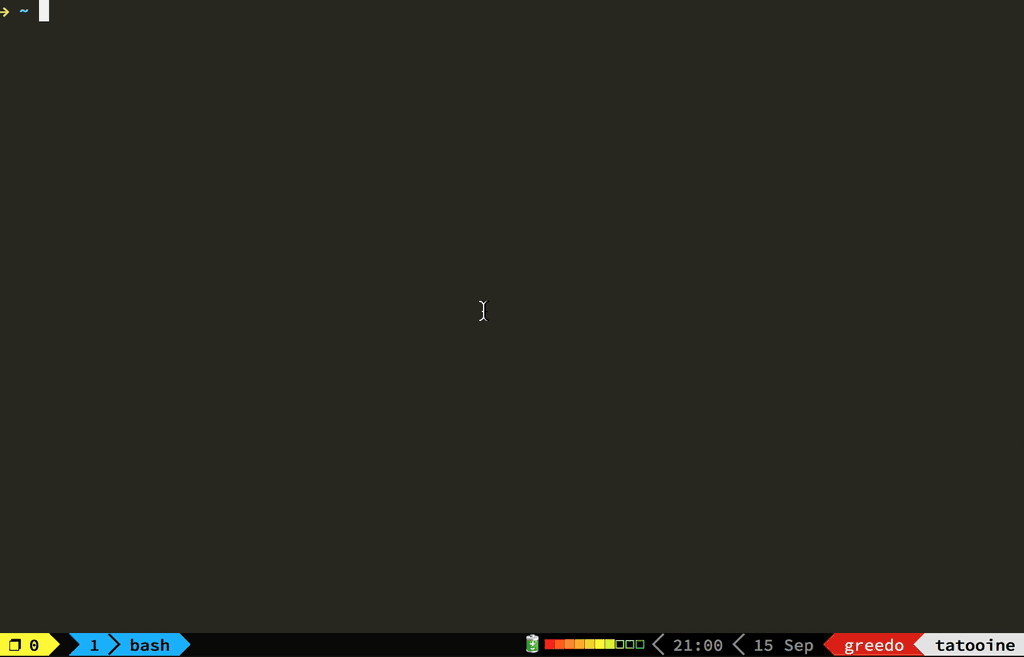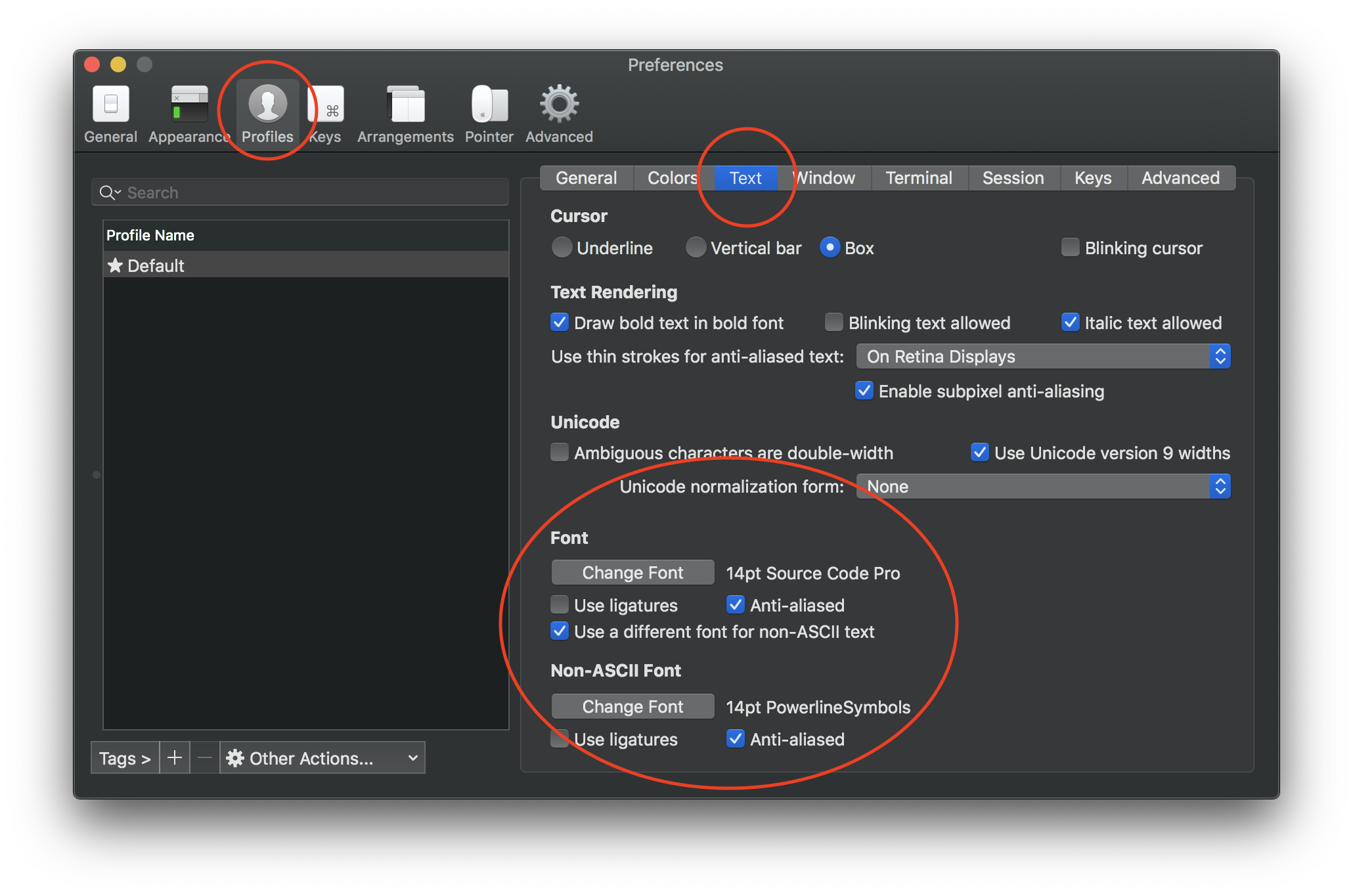.tmux
Self-contained, pretty and versatile .tmux.conf configuration file.

Installation
Requirements:
- tmux
>= 2.1(soon>= 2.4) running inside Linux, Mac, OpenBSD, Cygwin
or WSL - awk, perl and sed
- outside of tmux,
$TERMmust be set toxterm-256color
To install, run the following from your terminal: (you may want to backup your
existing ~/.tmux.conf first)
$ cd
$ git clone https://github.com/gpakosz/.tmux.git
$ ln -s -f .tmux/.tmux.conf
$ cp .tmux/.tmux.conf.local .
💡 You can clone the repository anywhere you want, provided you create the
proper ~/.tmux.conf symlink and you copy the .tmux.conf.local sample file in
your home directory:
$ git clone https://github.com/gpakosz/.tmux.git /path/to/oh-my-tmux
$ ln -s -f /path/to/oh-my-tmux/.tmux.conf ~/.tmux.conf
$ cp /path/to/oh-my-tmux/.tmux.conf.local ~/.tmux.conf.local
Then proceed to customize your ~/.tmux.conf.local copy.
If you’re a Vim user, setting the $EDITOR environment variable to vim will
enable and further customize the vi-style key bindings (see tmux manual).
If you’re new to tmux, I recommend you read tmux 2: Productive Mouse-Free
Development by @bphogan.
Troubleshooting
-
I’m running tmux
HEADand things don’t work properly. What should I do?Please open an issue describing what doesn’t work with upcoming tmux. I’ll do
my best to address it. -
Status line is broken and/or gets duplicated at the bottom of the screen.
What gives?This particularly happens on Linux when the distribution provides a version
of glib that received Unicode 9.0 upgrades (glib>= 2.50.1) while providing
a version of glibc that didn’t (glibc< 2.26). You may also configure
LC_CTYPEto use anUTF-8locale. Typically VTE based terminal emulators
rely on glib’sg_unichar_iswide()function while tmux relies on glibc’s
wcwidth()function. When these two functions disagree, display gets messed
up.This can also happen on macOS when using iTerm2 and “Use Unicode version 9
character widths” is enabled inPreferences... > Profiles > TextFor that reason, the default
~/.tmux.conf.localfile stopped using Unicode
characters for which width changed in between Unicode 8.0 and 9.0 standards,
as well as Emojis. -
I installed Powerline and/or (patched) fonts but can’t see Powerline
symbols.First, you don’t need to install Powerline. You only need fonts patched with
Powerline symbols or the standalonePowerlineSymbols.otffont. Then make
sure your~/.tmux.conf.localcopy uses the right code points for
tmux_conf_theme_left_separator_XXXvalues. -
I’m using Bash On Windows (WSL), colors and Powerline look are broken.
There is currently a bug in the new console powering Bash On Windows
preventing text attributes (bold, underscore, …) to combine properly with
colors. The workaround is to search your~/.tmux.conf.localcopy and
replace attributes with'none'.Also, until Window’s console replaces its GDI based render with a DirectWrite
one, Powerline symbols will be broken.The alternative is to use the Mintty terminal for WSL.
Features
C-aacts as secondary prefix, while keeping defaultC-bprefix- visual theme inspired by Powerline
- maximize any pane to a new window with
<prefix> + - SSH/Mosh aware username and hostname status line information
- mouse mode toggle with
<prefix> m - automatic usage of
reattach-to-user-namespace
if available - laptop battery status line information
- uptime status line information
- optional highlight of focused pane (tmux
>= 2.1) - configurable new windows and panes behavior (optionally retain current path)
- SSH/Mosh aware split pane (reconnects to remote server)
- copy to OS clipboard (needs
reattach-to-user-namespace
on macOS,xselorxclipon Linux) - support for 4-digit hexadecimal Unicode characters (requires
perlor Bash >= 4.1.2) - Facebook PathPicker integration if available
- Urlview integration if available
The "maximize any pane to a new window with <prefix> +" feature is different
from builtin resize-pane -Z as it allows you to further split a maximized
pane. It’s also more flexible by allowing you to maximize a pane to a new
window, then change window, then go back and the pane is still in maximized
state in its own window. You can then minimize a pane by using <prefix> +
either from the source window or the maximized window.

Mouse mode allows you to set the active window, set the active pane, resize
panes and automatically switches to copy-mode to select text.

Bindings
tmux may be controlled from an attached client by using a key combination of a
prefix key, followed by a command key. This configuration uses C-a as a
secondary prefix while keeping C-b as the default prefix. In the following
list of key bindings:
<prefix>means you have to either hit Ctrl + a or Ctrl + b<prefix> cmeans you have to hit Ctrl + a or Ctrl + b followed by c<prefix> C-cmeans you have to hit Ctrl + a or Ctrl + b followed by Ctrl + c
This configuration uses the following bindings:
-
<prefix> eopens~/.tmux.conf.localwith the editor defined by the
$EDITORenvironment variable (defaults tovimwhen empty) -
<prefix> rreloads the configuration -
C-lclears both the screen and the tmux history -
<prefix> C-ccreates a new session -
<prefix> C-flets you switch to another session by name -
<prefix> C-hand<prefix> C-llet you navigate windows (default
<prefix> nand<prefix> pare unbound) -
<prefix> Tabbrings you to the last active window -
<prefix> -splits the current pane vertically -
<prefix> _splits the current pane horizontally -
<prefix> h,<prefix> j,<prefix> kand<prefix> llet you navigate
panes ala Vim -
<prefix> H,<prefix> J,<prefix> K,<prefix> Llet you resize panes -
<prefix> <and<prefix> >let you swap panes -
<prefix> +maximizes the current pane to a new window -
<prefix> mtoggles mouse mode on or off -
<prefix> Ulaunches Urlview (if available) -
<prefix> Flaunches Facebook PathPicker (if available) -
<prefix> Enterenters copy-mode -
<prefix> blists the paste-buffers -
<prefix> ppastes from the top paste-buffer -
<prefix> Plets you choose the paste-buffer to paste from
Additionally, copy-mode-vi matches my own Vim configuration
Bindings for copy-mode-vi:
vbegins selection / visual modeC-vtoggles between blockwise visual mode and visual modeHjumps to the start of lineLjumps to the end of lineycopies the selection to the top paste-bufferEscapecancels the current operation
Configuration
While this configuration tries to bring sane default settings, you may want to
customize it further to your needs. Instead of altering the ~/.tmux.conf file
and diverging from upstream, the proper way is to edit the ~/.tmux.conf.local
file.
Please refer to the sample .tmux.conf.local file to know more about variables
you can adjust to alter different behaviors. Pressing <prefix> e will open
~/.tmux.conf.local with the editor defined by the $EDITOR environment
variable (defaults to vim when empty).
Enabling the Powerline look
Powerline originated as a status-line plugin for Vim. Its popular eye-catching
look is based on the use of special symbols: 
To make use of these symbols, there are several options:
- use a font that already bundles those: this is e.g. the case of the
2.030R-ro/1.050R-it version of the Source Code Pro font - use a pre-patched font
- use your preferred font along with the Powerline font (that
only contains the Powerline symbols): this highly depends on your operating
system and your terminal emulator, for instance here’s a
screenshot of iTerm2 configured to usePowerlineSymbols.otf

Please see the Powerline manual for further details.
Then edit your ~/.tmux.conf.local copy (with <prefix> e) and adjust the
following variables:
tmux_conf_theme_left_separator_main='\uE0B0'
tmux_conf_theme_left_separator_sub='\uE0B1'
tmux_conf_theme_right_separator_main='\uE0B2'
tmux_conf_theme_right_separator_sub='\uE0B3'
Configuring the status line
Contrary to the first iterations of this configuration, by now you have total
control on the content and order of status-left and status-right.
Edit your ~/.tmux.conf.local copy (<prefix> e) and adjust the
tmux_conf_theme_status_left and tmux_conf_theme_status_right variables to
your own preferences.
This configuration supports the following builtin variables:
#{battery_bar}: horizontal battery charge bar#{battery_percentage}: battery percentage#{battery_status}: is battery charging or discharging?#{battery_vbar}: vertical battery charge bar#{circled_session_name}: circled session number, up to 20#{hostname}: SSH/Mosh aware hostname information#{hostname_ssh}: SSH/Mosh aware hostname information, blank when not
connected to a remote server through SSH/Mosh#{loadavg}: load average#{pairing}: is session attached to more than one client?#{prefix}: is prefix being depressed?#{root}: is current user root?#{synchronized}: are the panes synchronized?#{uptime_y}: uptime years#{uptime_d}: uptime days, modulo 365 when#{uptime_y}is used#{uptime_h}: uptime hours#{uptime_m}: uptime minutes#{uptime_s}: uptime seconds#{username}: SSH/Mosh aware username information#{username_ssh}: SSH aware username information, blank when not connected
to a remote server through SSH/Mosh
Beside custom variables mentioned above, the tmux_conf_theme_status_left and
tmux_conf_theme_status_right variables support usual tmux syntax, e.g. using
#() to call an external command that inserts weather information provided by
wttr.in:
tmux_conf_theme_status_right='#{prefix}#{pairing}#{synchronized} #(curl -m 1 wttr.in?format=3 2>/dev/null; sleep 900) , %R , %d %b | #{username}#{root} | #{hostname} '
The sleep 900 call makes sure the network request is issued at most every 15
minutes whatever the value of status-interval.

💡 You can also define your own custom variables. See the sample
.tmux.conf.local file for instructions.
Finally, remember tmux_conf_theme_status_left and
tmux_conf_theme_status_right end up being given to tmux as status-left and
status-right which means they’re passed through strftime(). As such, the %
character has a special meaning and needs to be escaped by doubling it, e.g.
tmux_conf_theme_status_right='#(echo foo %% bar)'
See man 3 strftime.
Accessing the macOS clipboard from within tmux sessions
Chris Johnsen created the reattach-to-user-namespace
utility that makes pbcopy and pbpaste work
again within tmux.
To install reattach-to-user-namespace, use either MacPorts or
Homebrew:
$ port install tmux-pasteboard
or
$ brew install reattach-to-user-namespace
Once installed, reattach-to-usernamespace will be automatically detected.
Using the configuration under Cygwin within Mintty
I don’t recommend running this configuration with Cygwin anymore. Forking
under Cygwin is extremely slow and this configuration issues a lot of
run-shell commands under the hood. As such, you will experience high CPU
usage. As an alternative consider using Mintty terminal for WSL.

It is possible to use this configuration under Cygwin within Mintty, however
support for Unicode symbols and emojis lacks behind Mac and Linux.
Particularly, Mintty’s text rendering is implemented with GDI which has
limitations:
- color emojis are only available through DirectWrite starting with Windows 8.1
- display of double width symbols, like the battery discharging symbol indicator
(U+1F50B) is buggy
To get Unicode symbols displayed properly, you have to use font linking.
Open regedit.exe then navigate to the registry key at
HKEY_LOCAL_MACHINE\SOFTWARE\Microsoft\Windows NT\CurrentVersion\FontLink\SystemLink
and add a new entry for you preferred font to link it with the Segoe UI Symbol
font.






















 2855
2855











 被折叠的 条评论
为什么被折叠?
被折叠的 条评论
为什么被折叠?








